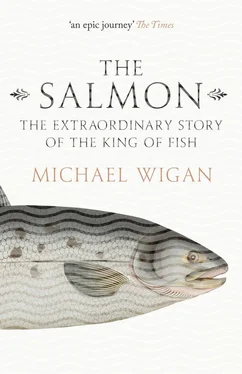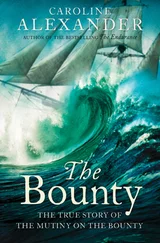Salmon capture was taken to a high art. If the water was moving fast the salmon were swept into a fenced enclosure. The single exit was a grid shelf sloping upwards; escaping fish marooned themselves on the grid, struggling upstream as they attempted to reach flowing water again. Neat.
Snaring fish was a various art. Rocks on the river-bed were designed in hoops or ‘wing-dams’ with the open end upstream. There could be a series of these ring structures widening out with the river. On the ebb tide salmon fell back in the river-mouth and were stranded. The rock-traps can be seen in outline today, still in place even though modern techniques have rendered them obsolete. The top rocks have been swept away in centuries of spates, but the river-bed structures remain, jawbones from which the teeth have fallen.
They are as evident in western Europe as they are in the Pacific Northwest, but in the former place no one has been looking for them or trying to build a picture of Stone Age salmon capture. If you go to the Grimersta River on Lewis, in Scotland’s Outer Hebrides, a prolific salmon system, you can find the same primeval remains of what at one time supplied local Outer Hebrideans with their winter food supply. The most elementary aspects of food harvest have a tendency not to alter much.
Weirs were angled to guide fish towards a centre-pass where the trap would be positioned. I have seen salmon channelled this way in Canada for counting and stock assessment. It works unerringly and the flow of the water keeps the latticework or stake-fence in place. Sometimes densely foliated tree branches are used to fill the bigger gaps. All the system needs is salmon with the urge to go upstream and water pushing the other way. Usually the more delicate lattice structures were taken away after the salmon run and the basic structures, especially when of rock, were left in place. If necessary they were repaired and rebuilt in springtime.
Tricking salmon into net-ends or ‘bunts’ was a brain-teaser which produced ingenious contraptions. The Indians worked out that salmon could be deflected by the appearance of pendant vertical lines which, had they attempted, the fish could have swum through. But the salmon opted to go in the direction of the tidal current and could be fooled into the upper layer of the water even though the water below was a lot deeper. A loose cats-cradle of connected lines, kept in place by sinker-weights and buoys, was enough to direct the salmon to where spear-wielding fishermen awaited them.
Bunches of rye grass were tied to the floor of the loose cradle of line to create the illusion of a floor or river-bed. This kept the fish in the river’s upper level heading for the denser-woven net near the shore through which they could not escape. Guile and knowledge of the quarry were essential in the capture of this turbo-charged fish. A salmon can outswim any creature in the river, and indeed most in the ocean.
In some ways it is peculiar that the Indians never developed the art of rod-angling. In the Azores today medium-sized fishing boats go to sea to take tuna, armed with bunches of fishing poles which are fished manually by fishermen just as day-boat anglers jig for pollack and mackerel. Rod and line is simply the best way of catching tuna. Additionally, rod-caught fish remain clean and attract the highest prices in the market.
The Indians approximated to this with line-fishing by trolling. Trolling from canoes took place in the bays and inlets before the fish range was narrowed by the confinement of rivers. A witness at the time describes what the Nootka Indians did:
‘For slimness and invisibility the braided leaders were made from women’s hair, or in rougher water from the quills of birds or porcupines. A hook was baited with fresh sprat or herring, and the line was attached to the solo canoeist’s paddle. The whole rig was sunk with small sinker stones. As the oarsman moved his paddle back and forth a slow jerking movement of the hook attracted the salmon. The paddle was then handled in such a way that the salmon was boated.’
You may ask, what were the hooks made from in a culture without metal? It is ingenious. ‘Bentwood’, or wood of hemlock, balsam, fir or spruce branches were used, but taken only from the places there were knots. For knots were denser than ordinary wood and instead of floating, sank. This wood was shaved to the right slimness, then steamed and pressed into a hook-shaped mould. Deer tallow rubbed onto the hook before cooling prevented the hooped construction re-opening. The barbs, lashed on, were fashioned from bone.
The ways in which Pacific-coast salmon were utilised once extracted from their natural element were diverse. Presumably some were used to fuel the energies of hungry fishermen and trappers and eaten fresh. Summer diets consisted of berries and shellfish; salmon was a burst of marine protein. But the bulk of the harvest was preserved for winter by drying and smoking. Nineteenth-century photographs show Indians dip-netting, scoop- and bag-netting and catching salmon in a multifarious manner, with the racks of fish drying in the background. Just as the weirs were often enormous structures involving the use of entire trees, and very long and strongly built, the drying-racks could be structures bigger than houses. Fir boughs protected the fish from direct sun and racks were positioned to catch warm winds for drying. Anything near ground level would attract grizzlies, hence the structures were built aloft.
Weather was all-important. There were good seasons for curing and drying fish, which was ideally done outside. If it had to be done inside, as much of the salmon harvest as could be accommodated was brought in. But for the really large-scale curing, space was needed, and that relied on clement conditions. Complete failure to cure the winter food supply successfully could lead to local starvations. There are a number of peoples, like the Han of the Yukon River, who critically depended on salmon runs for their survival over winter.
The V-shaped drying-racks could handle hundreds of salmon sides. Caches for salmon were built on stilts both to catch the wind and to keep bears off, and they were considerable structures. Some were the size of residential log cabins. There is a photograph of a cache built on several different floors climbing a single tree and connected by ladders. The Indians had wooden tongs for lifting fish. Strainers for removing them from cooking-pots were constructed of seal-ribs. Knives were made of mussel shells, and fish skins were dried on triangular blocks designed to stretch them. The number of varying utensils created to manage the salmon harvest equals the refinement of a modern kitchen equipment range. But all came from at-hand natural products. Tube-like bottles were made from the hollow necks of sea-kelp fronds.
The salmon were not only used for preserved food and skins. On the Fraser River the oil was taken from decomposing salmon bodies which had been left in troughs in the sun to rot, allowing the oil to seep to the bottom. Oil was procured too from the livers of dogfish and cod, and also from the bodies of eulachon (small oily river fish captured in shoals). Salmon roe was hung separately on racks and eaten when decomposed. Alternatively, salmon roe was sunk in boxes below the tide and rotted there before being consumed. Perhaps this is no more strange than raw salmon or gravlax being eaten in Scandinavia today. To many people, gravlax is the best salmon preparation of all.
The importance of the salmon in north-west Pacific culture is reflected in the artistry which was devoted to decoration of the tools deployed in their capture. Salmon was regarded as a sacred food resource with sacramental and life-saving qualities and was accordingly a repeat symbol in the region’s famous art. A nineteenth-century French missionary staying in a Huron fishing village described the eloquence of local preachers whose job it was to persuade salmon to come into the nets and be caught. His sermons were theatrical performances attended by the village in a hushed silence. Salmon, remember, possess souls.
Читать дальше












